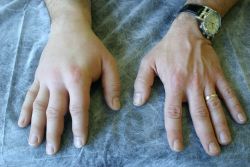Angiodema

Angioedema is a deep, short-lived swelling that can occur anywhere below or within the skin. Skin angioedema swellings are usually pale and uncomfortable rather than red and itchy. They generally last longer than superficial weals and often for days. Angioedema can also occur below mucous membranes of the mouth and genitalia. In rare situations, it can affect the bowel and bladder causing pain due to obstruction without being visible. Angioedema may be a feature of urticaria where it is due to histamine release from mast cells and responds to the same treatments as weals. It may also be a feature of anaphylaxis if it causes choking as a result of swelling within the throat. However, if angioedema occurs without weals it may be caused by a completely different mediator called bradykinin.
This may cause abdominal pain or throat swellings, which need completely different treatments from urticaria. Doctors try to understand from the story whether angioedema occurs with or without weals since this helps them to work out whether the swellings are due to histamine or bradykinin but it can be difficult to tell. A proportion of patients with bradykinin-induced angioedema will have inherited their condition. This is known as hereditary angioedema. Three types are currently recognized with different laboratory findings (Type I, II and III). About 50% of the children of affected patients are at risk of carrying the genetic abnormality that results in a reduction in function of an important enzyme inhibitor that controls several pathways necessary for good health.
Diagnosis
Management
Attacks of bradykinin-induced angioedema may be frequent or infrequent but usually begin in childhood. They may present with severe abdominal pain due to obstruction of the gut so they are often diagnosed late when there is no family history to guide the correct diagnosis. Of greater concern for patients with the condition is the knowledge that swellings may affect the throat severely so urgent appropriate therapy is required to minimize the risk of choking. The best treatment until recently was an emergency infusion of purified C1 inhibitor into the vein to replace the missing protein. A relatively new inhibitor of bradykinin is now available that is injected under the skin once an attack starts and appears to work as well as C1 inhibitor although studies comparing the two therapies have not been done yet. Patients who develop frequent attacks of hereditary angioedema often benefit from taking medications to prevent them but there is still no perfect preventative measure. It is now recognized that women on oestrogen hormone therapies are at increased risk of angioedema and should be advised to find alternatives whenever possible.
By complete contrast to bradykinin-induced angioedema, idiopathic (histamine-mediated) angioedema responds well in an emergency to adrenaline (epinephrine). Treatment with antihistamines and steroids are often given. However, steroids should only be taken in short courses to minimize the risk of side effects. Antihistamines are sometimes insufficient to prevent angioedema on their own and then other treatments are often given as well.
